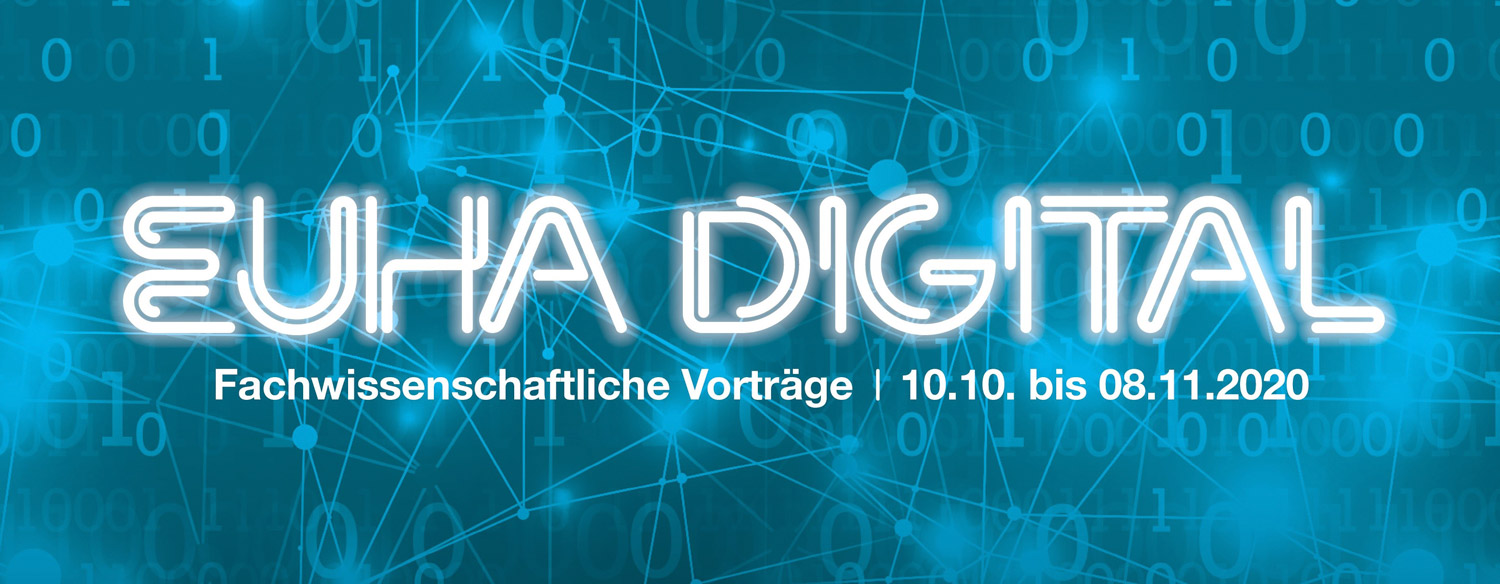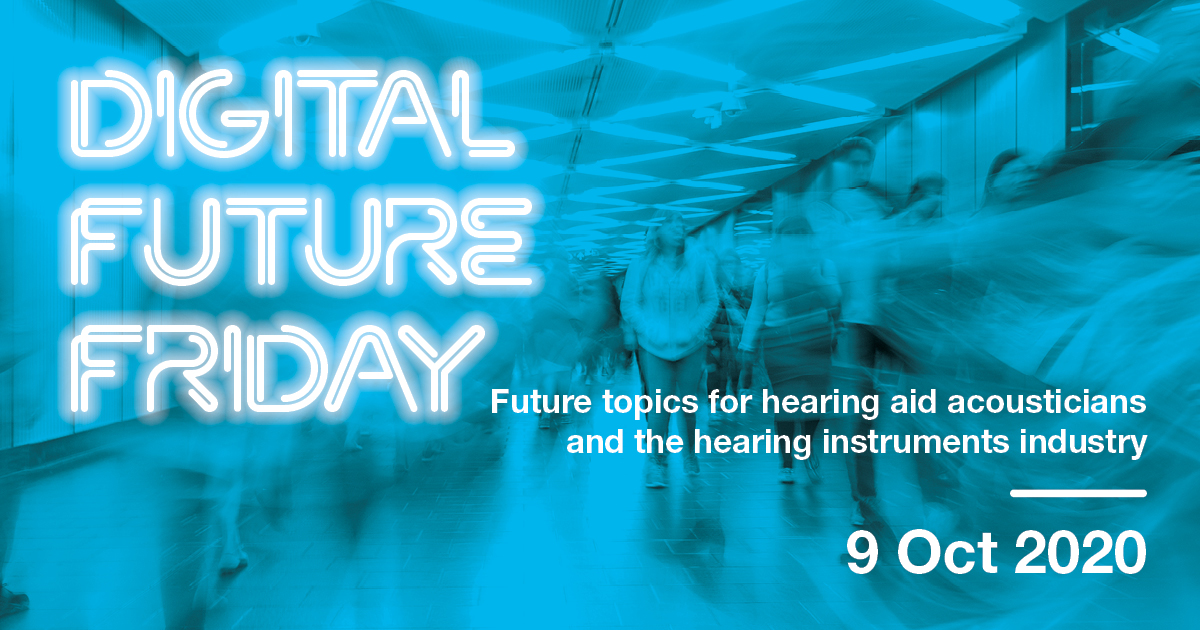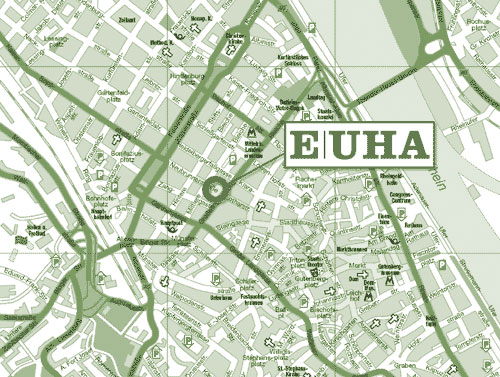
Digital EUHA Congress 2020
EUHA digital
EUHA digital is a series of specialist lectures that have a lot to offer! It features speakers from different fields of medicine, science, and industry who are part of a community paving the way for the future of hearing aid acoustics. Benefit from this format to boost your personal professional education!


Prof. Dr. Dr. Birger Kollmeier
Oldenburg (Germany)
“Hearing for All: From empirical hearing research towards modern precision audiology”
Understanding spoken language is the basis of our culture. Even an incipient, mild hearing loss has consequences for speech recognition in noise. With increasing hearing loss, suprathreshold distortion effects occur (“misaudition”) and details in the auditory “internal representation” of the exterior acoustic scene are lost. How can we efficiently assess the most important factors of impaired hearing, and which technical possibilities do we have to compensate for an incipient, mild-to-moderate hearing disorder?
The talk provides an insight into ongoing research and highlights of the Cluster of Excellence “Hearing4All” (Oldenburg/Hanover). We cover biophysical foundations of the impaired hearing process, clinical audiological diagnostics and therapy as well as assistive hearing systems for daily live.
A focus is laid on the interaction between experiments and hearing theory. Using methods of machine learning and automatic speech recognition helps us to provide precision diagnosis, and to exactly predict the gain in speech recognition achieved by providing a particular hearing system or implant. Future developments therefore aim at a precise, individualised supply and rehabilitation with hearing devices that are based on an exact prediction of individual benefit from each device.


Achin Bhowmik, Ph.D., & Dave Fabry, Ph.D.
Eden Prairie (USA)
“The Speed of Innovation”
The hearing healthcare industry’s continued evolution could lead to the best decade yet for our profession. There is no question that emerging technologies such as embedded sensors and artificial intelligence are changing the hearing health landscape.
Participants will have an insightful look into the decade ahead for the industry. Here, participants will learn about the future of technology, strategy, and service in the dynamic hearing healthcare industry, how to leverage these new innovations in today’s dynamic market landscape.

Dr. Jérôme Servais
Mannheim (Germany)
“Networking acousticians and clinics”
Technical hearing solutions have become increasingly complex over the past decade. Our patients are looking for an overall solution rather than for partial treatment by different actors. The overlap between the healthcare trade and the clinical engineer is clear. As the senior consultant at the hearing centre at Mannheim University Medical Centre (UMM), it has been my aim over the past seven years to significantly optimise the cooperation between the hearing care professional and us so as to meet our customers’ needs.
In the next step, we favour quantifiable networking with one another to ensure quality. So that our patients can continue to be cared for by the hearing care professional close to their home, a solution for billing the services rendered has yet to be achieved. The lecture will describe the experience gained over the last few years of cochlear implant care in a cooperation between the hearing care professional and the ENT clinic, as well as the opportunities for further networking. So far, the possibilities for the hearing care professional to bill the CI aftercare service remain unresolved.

Dr. Florian Schmidt
Lübeck (Germany)
“Dependence of speech intelligibility on the electrical stimulation level and changes in impedance during the first year of application: Old and new insights”
Hearing aid acousticians are increasingly involved in the fitting of CI processors, especially if they have completed further training to become a CI audiologist. A major challenge is the adjustment of the electrical stimulation levels of the T and C levels during the first year of application. Readjustments are necessary on a regular basis to ensure progress in speech intelligibility. It is known from studies that T and C levels initially increase before they stabilise after one to three months. Furthermore, speech intelligibility increases up to a saturation level of 80%.
Most studies are limited to measurements at monthly intervals. Fluctuations in smaller intervals are not recorded. However, patients can certainly notice them in their everyday lives. In the following study, the temporal resolution of such collected data was subsequently increased using the moving average method. Finally, the data were examined for correlations. For the change in speech intelligibility over time we found three phases:
- impedance-driven increase to 60% in the first two months after activation,
- T level oscillating improvement of 20% in the following 10-15 months,
- saturation of the increase in speech intelligibility at 80% after 1.5 years.

Dr. habil. Tobias Weißgerber
Frankfurt am Main (Germany)
“Impact of the noise condition on speech perception and listening effort in users of auditory implants”
Speech perception in complex listening situations with multiple noise sources and/or in reverberation is a particular challenge for cochlear implant (CI) users. In addition, CI users often suffer from fatigue as a result of increased listening effort.
The aim of this study was to investigate speech perception and listening effort of CI users in complex noise and reverberation.
The speech reception threshold (SRT) in noise was measured in free-field and reverberation. The ACALES method was integrated in the Oldenburg sentence test procedure to assess subjectively perceived listening effort and SRT simultaneously. CI users as well as a control group of normal hearing (NH) subjects participated in the study.
The SRT in free-field (modulated noise sources) was 20.2 dB SNR in the NH group. SRT in reverberation was deteriorated by 6 dB. In initial measurements with bilateral CI users, an SRT of 4.7 dB SNR (free-field) and 0.9 dB SNR (reverberation) was achieved. A significant influence of the noise condition on listening effort was shown. At 0 dB SNR, listening effort in the CI group was significantly higher than in the NH group.

Sascha Haag M. A.
Erlangen (Germany)
“Hearable versus medical device – competitive battle or opportunity?”
Wireless plug-in headphones, so-called earbuds, are undoubtedly on the advance. Thanks to bluetooth and improved battery technologies, wired systems are becoming increasingly obsolete. Meanwhile, some well-known consumer electronics manufacturers offer earbuds or hearables whose functions seem to be getting closer and closer to hearing aid functions. For example, they may have a “transparency” mode that supports listening to the environment while wearing the device.
In this presentation, we will introduce you to trends in consumer electronics, and draw a comparison with the latest hearing system technologies. We will take a closer look at the features that hearables use with environmental amplification. Measurements show the difference to audiological medical devices and the outstanding performance of advanced hearing aid technology.

Prof. Dr. Dr. Ulrich Hoppe
Erlangen (Germany)
“Influence of fitting practice on satisfaction, feeling of security and self-confidence among hearing aid users”
The assessment of a hearing aid (HA) supply must take amplification, speech intelligibility, and the customers’ ranking of hearing in everyday life into account. Other targets include, for instance, their change in the feeling of security and self-confidence. The aim of the study was to investigate the influence of fitting practice on these aspects of benefit.
For this purpose, as part of a market analysis (Hearing Instrument Usage Monitor, HIM) in which 195 specialist shops (acousticians) were involved, a total of n = 554 customers was surveyed, for whom a hearing aid fitting was carried out.
On average, 2.1 ± 0.9 hearing aids were fitted for each customer. This was done on average during 4.2 ± 1.5 fitting sessions over 5.7 weeks. For 95% of customers, an increase in everyday hearing was observed, 88% felt more confident with the HA in everyday life, and 91% stated that they would miss their hearing aids. For all success parameters, an optimum was found for four to five sessions, and an overall duration of the trial period of three to six weeks.
Conclusion: four to five sessions over a period of at least three weeks are suitable for a successful hearing aid supply.

Dr. Hendrik Husstedt
Lübeck (Germany)
“Custom-made hearing protectors with hearing aids as medical devices and personal protective equipment (PPE)”
Noisy environments are challenging especially for people with hearing loss. On the one hand, the ears must be protected from loud sounds, and on the other hand, hearing loss needs to be compensated for acoustic orientation and communication.
Custom-made hearing protectors with hearing aids and special certification as medical devices and personal protective equipment (PPE) can be a solution. These devices can amplify soft sounds to compensate for the hearing loss, and reduce loud sounds to protect the ears. However, due to the complex certification procedure for those devices, the number of products available is limited.
In addition, complex certification delays the launch of new products so that it takes much longer to make this new technology available than is the case for regular hearing aids.
To improve the current situation, a separate procedure for certification should be implemented where the custom earmould and the hearing aid are tested individually. This is meant to reduce complexity and increase flexibility. In addition, a more detailed testing procedure for the hearing aids and the fitting software is intended. We shall give insights into the ideas of the new certification process, and present results of a study demonstrating its applicability in practice.

Erich Bayer
Munich (Germany)
“Smart earmoulds for smart hearing systems”
Our hearing systems are getting smarter and are now opening up options for hearing aid acousticians/audiologists that we could only dream of a few years ago. But of what use are the technical features offered by manufacturers if we cannot use them for our customers’ benefit?
Similar to the technological solutions provided by the hearing aid industry, the world of custom-made earmoulds with its passive audiological effects has changed enormously. Undoubtedly, for more than 90% of our customers in Germany the days of sealing zones are over.
Material-independent earmould designs are required which have neither a full-contact part of the earmould in the auditory canal nor any material covering on the underside of the tragus. Custom-made earmoulds are preferable as they offer minimal material contact with the moving auditory canal, guarantee a stable fit without causing a foreign body sensation while still meeting audiological requirements.
These requirements for smart custom-made earmoulds and corresponding smart designs will be presented and discussed.

Hans-Christian Drechsler
Ballerup (Denmark)
“Metrics to quantify performance of hearing aid systems in different listening environments”
In this presentation, we will review metrics to characterise the performance of a hearing system in three types of listening environments, and present results that benchmark performance across several hearing aid system approaches. The auditory system makes use of both monaural and binaural acoustic cues to localise, enhance, and diminish sounds in the environment at will.
These advantages can satisfy different listening priorities and needs in different acoustic environments. We have identified three broad categories of environments where similar listening priorities are likely to predominate.
These include:
- Environments in which the brain can leverage acoustic cues to maximise listening performance and sound quality.
- Environments where the auditory system needs to focus on the ear with the best signal-to-noise ratio, while using the other ear to provide missing information caused by the head shadow effect.
- Complex environments where noise is diffuse and there is no ear-dependent advantage.
The presentation will primarily focus on the development process of hearing aids that work in tandem with the auditory system on the acoustical, peripheral nervous system, and central nervous system level to support listening strategies in these different types of environments. This includes the evaluation of metrics that quantify performance in each of these areas. The metrics used for this are the Inter-Subject Spectral Difference (Middelbrooks, 1999), the Better Ear/Situational Awareness Index (Piechowiak et al., 2018), and the Directivity Index (Dittberner and Bentler, 2007). By using these measures to guide development, it is possible to create a system that is consistent with users’ auditory behaviour in their real-life listening environments. Additionally, the presentation will review the development of a completely new receiver type that supports the previously described signal-processing strategies.

Dipl.-Ing. Horst Warncke
Hamburg (Germany)
“Watch the brain listen”
Selective hearing describes the ability to hear the desired signals from a mixture of sounds, to follow them, and at the same time to suppress unwanted sounds. Previous theories assumed that selective perception occurs by focusing on the desired sounds, as if they were highlighted by a spotlight. According to the latest studies (O’Sullivan et al., 2019), such selection functions more like a filter that evaluates all information in order to then prioritise what is desired. The brain needs as much information as possible to “feed” the filter. How the brain implements selective hearing can be demonstrated for the first time by high-resolution, 64-channel EEG measurements. A new procedure was developed for use with hearing systems to detect three different signals at the same time (Alickovic et al., 2019).
In one study, speech signals from two competing target speakers, covered by interference speakers, were used. The subjects should concentrate on one of the target speakers. EEG measurements were used to demonstrate whether target speakers can be heard selectively and whether interference speakers can be ignored; thus, the benefits of hearing system features can also be checked (Ng et al., 2019). A similar approach to checking selective attention in normal hearing is described by Puvvada et al. (2017) using magnetoencephalography (MEG). The MEG signals can be recorded using a helmet with 160 channels. Eriksholm Research Center is currently testing the use of MEG in people with hearing loss.
The current theory on selective hearing, EEG and MEG measurements, and their use with hearing systems will be explained in the lecture. I shall show that certain hearing aid features can actually support selective attention. Specifically, the first EEG study results will be presented.

Melanie Krüger, M.Sc.
Oldenburg (Germany)
“What is listening effort and how can we measure it in a daily routine?”
In interpersonal communication, listening and understanding of one’s counterpart is essential. In many everyday situations, however, background noise covers the spoken words, reducing speech intelligibility and increasing the effort to recognise speech in these situations. The measuring dimension of ‘listening effort’ can be determined using objective (e.g. EEG and pupillometry) as well as with subjective methods (scales and questionnaires).
Based on ‘ACALES’, the adaptive categorical listening effort method, the perceived listening effort can be measured. For this purpose, speech is presented in a background noise, and rated by the user on a scale from “no effort” to “extreme effort” how effortful it was to follow the speaker. The goal is to determine the individual listening effort function of the user.
In this talk, established measurement methods for determining listening effort will be presented, and knowledge from scientific studies using subjective listening effort scaling will be demonstrated. Finally, a short overview of the possible applications of listening effort measurements on a professional level will be given.

Christophe Lesimple
Bern (Swiss)
“Evaluation of a hearing aid fitting protocol optimised for active musicians”
Fitting hearing aids for musicians is a challenge because there is no universal acoustic model for music. Individual expectations cannot be defined in advance as the combination of musical instrument or style with hearing aids creates a wide range of listening conditions. We assume that hearing aid amplification can be optimised with the active participation of the musician during the fitting process to improve the music perception.
Twenty active musicians and hearing aid users were recruited to evaluate the optimised music protocol against the standard music program.
The optimised protocol is based on a trial and error process with the active participation of the musician. Both music programs improved the discrimination thresholds of pitch, duration, and level compared to the standard NAL-NL2 based hearing program. While the differences between the two music programs were not significant in the laboratory test, the optimised music program was preferred over the standard music program after the field test.
The results of this study confirm the need for audiologists and musicians to use a common language to optimise the technological potential offered by signal processing systems.

Simon Müller M. Sc.
Stuttgart (Germany)
“Artificial intelligence and its different applications”
The concept and use of artificial intelligence (AI) has found its way into our lives in a wide range of areas. It should be pointed out here that “AI” as an umbrella term neither indicates the mode of operation nor the scope of application. Thus, individual procedures, such as big-data applications, neural networks or machine learning algorithms, result in very different areas of use and man-machine interactions. For a more detailed understanding, not only the benefits but also the limitations of different AI applications have to be recognised.
Without sufficient transparency, it is often difficult to decide which benefits are provided by a specific type of intelligent technology.
The presentation will address different AI applications with regard to our everyday life, or their development, respectively. Furthermore, it will illustrate the differences in the perceptive abilities of humans and machines. In the field of audiology, AI benefits in everyday life will be demonstrated using the example of sound optimisation via a machine learning process. The aim of the talk is to enhance understanding of different AI technologies in order to facilitate differentiation between them.

Digital Future Friday
The Digital Future Friday was the kick-off to the event. In four keynote presentations from internationally renowned speakers, you will learn everything worth knowing about the most innovative topics from hearing aid acoustics and hearing aid technology.


Dave Fabry, Ph.D.,
Chief Innovation Officer, and
Archelle Georgiou, MD,
Chief Health Officer, Starkey Hearing Technologies
Putting the „AI“ in patient-centred hearing healthcare
Dr. Georgiou and Dr. Fabry will discuss the loneliness epidemic and why hearing is essential now, more than ever.
New barriers make it even more difficult to communicate with the doctors, nurses, and other healthcare providers to manage the many conditions that are associated with hearing loss. Discover how AI technology can assist you in actively engaging with your patients to advocate for better hearing healthcare.

Ken Kolderup,
Vice President Marketing, Bluetooth SIG, Kirkland, USA
Upcoming Bluetooth enhancements to improve the lives of people with hearing loss
Several years ago, the Bluetooth Special Interest Group (SIG) and hearing aid industry began a collaboration to enhance Bluetooth technology to better meet the needs of people with hearing loss.
The results of that effort will soon be completed and promise to significantly improve the availability, performance, and interoperability of Bluetooth enabled hearing aids. In addition, the upcoming enhancements will enable deployment of a true next generation assistive listening system (ALS) capable of providing a significantly better user experience than existing inductive loop systems.

Prof. Dr. Marlies Knipper,
Tübingen Hearing Research Centre, Dept. of Otorhinolaryngology, Head and Neck Surgery, Eberhard Karls University, Tübingen
“If you want to keep your brain sharp, take care of your ears”
It has recently been reported that hearing loss is associated with a significantly increased risk of developing dementia (Livingston et al., 2017, Lancet). The underlying connection between hearing loss and cognitive loss remains speculative and is attributed, among other aspects, to increasing mobility loss in hearing impaired people with untreated deafness. However, there has been evidence for some time (including our own research) that the causes between hearing and ‘cognition’ could be much more subtle, and may be related to the different functions of auditory fibres for normal hearing and brain function. We will discuss and examine such a differential function of hearing fibres for brain functions in different contexts: (i) auditory fibre types can influence our brain in very different ways during hearing development, (ii) they have very different vulnerabilities to noise and stress, as well as to age, (iii) they have very different functions for our understanding of language and memory performance, (iv) accordingly, they have very different consequences on language understanding and memory performance when injured.
With regard to our responsibility for members of future generations, who are getting older and at an increasing risk of developing hearing loss and dementia due to different leisure activities, questions and projects for the research and restoration of differential functions of auditory fibres should be pushed, and should be initiated and integrated into future therapy concepts as well as future strategies for the treatment of congenital and acquired hearing disorders.
Prof. Dr. Marlies Knipper has been a university professor of molecular hearing physiology at the Hearing Research Centre of the Department of Otorhinolaryngology, Head and Neck Surgery, at Eberhard Karls University in Tübingen since 2009. Her research focuses on the causes of congenital deafness, tinnitus, age, and noise deafness, and the relationship between deafness and cognitive deficits.

Prof. Dr. Steffen Kreikemeier,
Department of acoustics and audiology at Aalen University
Remote fitting – opportunities and risks
Fitting a hearing aid via the internet? Who needs this? It makes sense in large countries with a low population density such as Australia where patients have long journeys to see the closest acoustician, but in Germany, Austria or France?
These are some of the most common statements related to remote fitting. The covid-19 pandemic brought new challenges to our lives. Remote access can be very useful, especially in times like these. Could remote fitting of hearing aids replace an individual live session with the patient and his or her family?
This is not in line with family-centred care (FCC). Who may benefit from an online approach of fitting? Fitting hearing aids via smartphone requires technophilia and a stable internet connection. More and more people at a higher age are used to using a smartphone, however, there is a big difference between making phone calls and being part of an online hearing aid fitting. Prof. Dr. Steffen Kreikemeier from the department of acoustics and audiology at Aalen University will show the complexity of remote fitting, and discuss opportunities and risks of such online approach.


